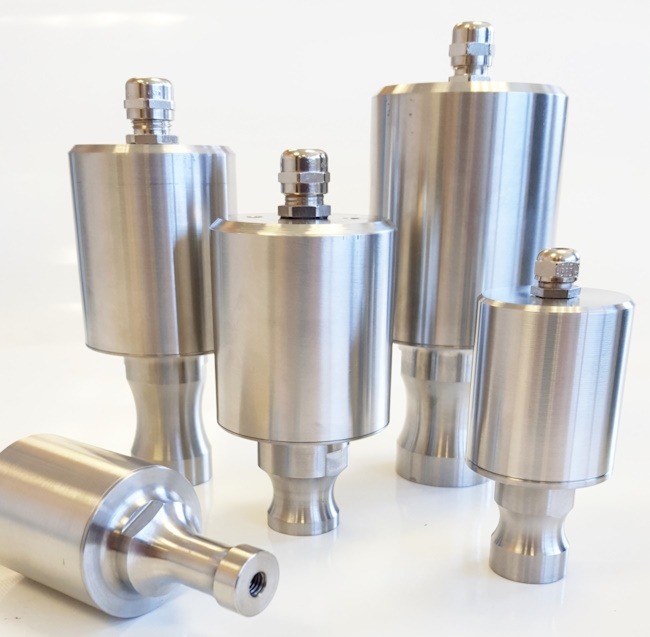The performance of ultrasonic equipment—thanks to advancements in electronics, design tools, and a better understanding of materials—offers new possibilities for the use of ultrasound in industry.
The Piezoelectric Effect: Definition and Origin
Although a number of principles can be used to generate ultrasound, transducers mainly use the piezoelectric effect to convert electrical energy into mechanical movement.
In 1880 Pierre and Jacques Curie demonstrated the piezoelectric effect on a quartz sample, which becomes electrically charged when subjected to compressive stress. Conversely, when electrical voltage is applied to the quartz it causes a deformation in the crystal.
Piezoelectric Transducer: What are ultrasonic transducers?
Ultrasound is produced by piezoelectric transducers. These transducers enable electrical energy to be converted into mechanical energy and vice versa. It’s best to specialize ultrasonic transducers according to their application:
- For emission: the properties sought are output and the capacity to emit a strong signal,
- for receiving: the sensitivity and signal/sound relationship are the characteristics which determine the performance of the piezoelectrical transducer.
Transducers can also be used for both emission and reception, particularly in measurement systems or testing technologies. In such cases, the transducer must balance the criteria described above.
There are many types of ultrasonic transducers available to meet the needs of most applications, across the ultrasonic frequency range starting at 16 kHz (as explained on the page about ultrasound principles). They can be classified by their use and/or frequency range. Two complementary technologies are implemented: one for low frequencies and one for high frequencies.

Use of Piezoelectric Ultrasonic Transducers at Low Frequencies
Low-frequency ultrasonic transducers are made by stacking piezoelectric ceramics between two metal parts that provide mechanical compression (Langevin-type transducer), or from a disc that utilizes the Poisson effect.
The power transducer is typically paired with two components to optimize energy transfer into the medium:
- The sonotrode, which transmits mechanical vibration to the medium. Its geometry is crucial for adapting the vibration amplitude produced by the transducer.
- The booster, which is optional and placed between the transducer and the sonotrode. It serves to amplify mechanical vibration.
Use of Piezoelectric Ultrasonic Transducers at High Frequencies
High-frequency transducers are made from a single ceramic, either homogeneous or piezo-composite. For measurement purposes, matching layers are used to optimize energy transfer into the propagation medium. The entire transducer is then protected by a membrane that is acoustically transparent to the signal.
High-frequency power transducers are being developed for various therapeutic medical applications.
Electronics
High-Power Ultrasound
An ultrasound device consists of power electronics suitable for the transducer. The generator power supply is created using a network supply. For medium-range power, some of our generators are supplied with voltages that are as low as 24 VDC.
The generator has two major roles:
- Conversion of a network voltage into a voltage suitablefor the transducer (which can exceed 1kV). Controlling this voltage enables the power delivered to the transducer to be controlled. There are many strategies for controlling the equipment correctly. These very much depend on the the application. Our generators can be adapted to the different issues posed by the application.
- Conversion of the network frequency to the resonance frequencyof the transducer. The transducer supplies its optimal power when it is at its resonance (or antiresonance) frequency. The electronics should therefore be able to control the frequency of the transducer which the environment varies depending on the medium. There are many strategies for controlling the equipment correctly. These very much depend on the application.
Power generators can supply from a few W up to 5 kWatts. Power transducers for welding are often limited to 3kW – 4kW, during very short excitation periods. For applications in fluids, such as cleaning, the transducer power is around several dozen kW. In these applications, the transducers are mounted in groups.
Our current range of NexTgen equipment is entirely numeric. The control functionality has been developed to ensure superior performance efficiency. They are to be used with an Ethernet connection to enable the « remote control » functionality by means of which our customer care people can run diagnostics and updates from a distance.
Bibliographical Notes:
Power ultrasonics: Applications of high-intensity Ultrasound:
Gallego-Juarez and Karl F.Graff – WOODHEAD PUBLISHING
Handbook on Application of Ultrasound – Sonochemistry and Sustainability:
Dong Chen, Sanjay K. Sharma, Ackmez Mudhoo – CRC Press
Sonochemistry: From Basic Principles to Innovative Applications
Juan Carlos Colmenares, Gregory Chatel – Springer
Ultrasonics: Fundamentals, Technologies, and Applications, Third Edition:
Dale Ensminger, Leonard J.Bond
La cavitation:
https://perso.imt-mines-albi.fr/~louisnar/CAVITATION/ultrasons.html
